高考英语大纲规定的24个语法梳理(二)
时间:2019-08-13 11:19:55 热度:37.1℃ 作者:网络

连词是虚词,不能在句中单独担任成分,只起连接作用。按其用法,连词可分为两大类:并列连词和从属连词。
1
并列连词
连接具有并列关系的词、短语或句子。
⒈ 并列关系:and,not only…but also…,both…and…,neither…nor…
如:I used to live in Paris and London.
Both Jane and Jim are interested in fishing.
The weather here is neither too cold nor too hot.
She is not only kind but also honest.
⒉ 转折关系:but,yet,while(然而),when(然而,偏偏)
如:The car is very old but it runs very fast.
The problem was a little hard,yet I was able to work it out.
The winter in Beijing is very cold while that of Kunming is warm.
Why did you borrow the book when you had one?
⒊ 选择关系:or,not…but…,either…or…
如:Would you like to live or would you like to stay?
He is not a teacher but a writer.
You can come either on Saturday or on Sunday.
⒋ 因果关系:for
如:It must have rained last night,for the ground is wet now.
The leaves of the trees are falling. for already autumn.
5. 区别
① and和or
⑴ 并列结构中,or通常用于否定句,and 用于肯定句。
⑵ 但有时and 也可用于否定句。请注意其不同特点:
如:There is no air or water in the moon.
There is no air and no water on the moon.
在否定中并列结构用or连接,但含有两个否定词的句子实际被看作是肯定结构,因此要用and。
判断改错:
(错)We will die without air and water.
(错)We cait live without air or water.
(对)We will die without air or water.
(对)We cant live without air and water.
② 表示选择的并列结构
⑴ or意思为“否则"。
I must work hard,or I will fail in the exam.
⑵ either,or 意思为”或者……或者……注意谓语动词采用就近原则。
Either you or I am right.
③ 表示转折或对比
⑴ but表示转折,while表示对比。
Some people love cats,while others hate them.
⑵ not…but…意思为“不是……而是……"not和but后面的用词要遵循一致原则。
They were not the bones of an animal,but(the bones) of a human being.
③ 表原因关系
⑴ for是并列连词,不能置于含两个并列分句的句子的句首,只能将其放在两个分句中间。
判断改错:
(错)For he is ill,he is absent today.
(对)He is absent today,for he is ill.
④ so,therefore
如:He hurt his leg, so he coudn't play in the game.
注意:a. 两个并列连词不能连用,但therefore,then,yet可以和并列连词连用。
You can watch TV, and /or you can go to bed.
b.although,yet 但although不能与but连用。
⑤ 注意:
not only,but also 关联两个分句时,一个分句因有否定词not而必须倒装。
如:Not only does he like reading stories,but also he can even write some.
neither…nor… 意思为“既不……也不……“谓语动词采用就近原则,与nor后的词保持一致。
⑥ 比较so和such
其规律由so与such的不同词性决定。such 是形容词,修饰名词或名词词组,so是副词,只能修饰形容词或副词。so还可与表示数量的形容词many,few,much,little连用,形成固定搭配。

⑴ so many 已成固定搭配,a lot of虽相当于many,但a lot of为名词性的,只能用such搭配。
⑵ so,that与such,that之间的转换即为so与such之间的转换。
2
从属连词
指在复合句中引导从句的连结词。
⒈ 常见的从属连词有:
引导时间状语从句的:after,before,when,as,while,since,until,till,as soon as
引导原因状语从句的:because,since,as
引导让步状语从句的:although,though,no matter(无论),even if (though)
引导条件状语从句的:if,unless,once,as (so) long as
引导结果状语从句的:so,so that,so…that…,such…that…
引导目的状语从句的:so,so that…,in order that…
引导比较状语从句的:as…as,not so (as),as,than
引导方式状语从句的:as,as if…,as though
引导地点状语从句的:where,wherever
引导名词性从句(主语,宾语、表语或同位语从句)的连词主要有:that,whether,if三个。其中that和whether间或还可以引起同位从句和状语从句。
⒉ 某些用法比较特殊的从属连词用法区别
① 当while,when,as引导时间状语从句时的区别:
⑴ while引导的状语从句中动词必须是延续性。谓语动词多为进行时,或状态动词的一般时。while的这些用法可用when代替,等于“at the time that",“during the time that”
如:Please keep quiet while(when)others are studying.
⑵ when除可指一段时间外,还可用来指一点时间,等于“at the time;when引出的时间状语从句中的谓语动词可以是终止性的,也可以是延续性的。因此主句和从句的谓语可以是一般时,进行时,或完成时。
如:When I went into the lab,the teacher was doing an experiment.(不能用while)
He often makes mistakes when he is speaking English (then 可换成while)
⑶ as 常可与when,while通用,但强调“一边、一边”。
如:As(when/while) I was walking down the street, I noticed a police car in front of number 37.
⑷ when 引导的状语从句中的主语与主句主语一致,主、谓是“主语+系动词”结构时,这时主语和系动词可以省略。
如:When (he was)young. he worked for a rich man.
She'll be here to give you help when (if it is)necessary.
⑸when有时代替if,引导条件句,意为“如果”“假如”。
如:I'll come when (if)I'm free.
② before作连词一般表示时间,意为“在.…之前”,但有些句子中这样译就显得别扭。
试看以下句子的翻译:He almost knocked me down before he saw.他且乎把我撞倒才看见我;
Before I could get in a word he had measure.没来得及插话,他已经给我量好了尺寸。
③ till,until作为介词式从属连词,只用于时间,引导时间状语短语或状语从句,用于否定句时,结构为not…until(till)主句谓语动词延续与非延续皆可,意为“直到……才……”。用于肯定句时,只与延续性动词连用,表示“到……为止”。
如:They played volleyball until(till)it got dark.
They didn't talk(延续)until(till) the interpreter(译员)came.
He didn't go to bed(非延续)until(till) the his father came back
但是,until可以放在句首,till则不行。
如:Until the last minute of the match we kept on playing.
Not until he finished his work did he go home.(倒装)
④ because,since,as引导原因状语时注意使用上的区别:
⑴ 如果原因构成句子的最主要部分,一般用because 因此because引导的从句往往放在句末。用why提问的句子,一定用because 回答。
如:He had to stay at home yesterday because he was ill.
⑵ 如原因已为人们所知,或不如句子的其他部分重要,就用as,或 since。since比as更正式些。as和since引导的从句一般放在句子的开头。
如:As you are tired,you had better rest/Since everyone is here,now let's begin.
⑤ although和though 引导让步状语从句往往用法一样,但注意以下区别:
⑴ although 用于各种文体,而though则多用于非正式的口语或书面语中。注意由 although,though 引导的从句后,主句不能用but,但可用副词yet,still。
如:Although/Though it rained all the morming, they still went on work或yet they went on working.
⑵ though 常与even连用,even though表示强调,意为“即使”,但不能说even although。
如:Even though he didn't understand a word,I dept smiling.
⑶ though可用作副词,意为“然而”,常用逗号与句子分开。lthough 则不能这样使用,它只作连词。
如:It was a quiet party,I had a good time though.
⑥ once作副词译“曾经”,作为连词译“一旦”,引导条件状语从句。相当于f的加强形式。
如:I don't believe he was once a thief.(once这是副词)
Once Aristotle(亚里士多德) had made up his mind that heavy objects always fell faster than light objects,he taugh as a truth to his students.(once连词)
⑦ umless引导条件状语从句等于if…not…
如:He'll accept the job unless the salary is too low.
⑧ 在用as if引导的方式状语从句及表语从句中,根据情况要使用虚拟语气。
例如:He talks as if he knew all about.但有时也可用直陈语气。
It looks as if it is going to rain.
⑨ whether,if引导从句的用法区别:
⑴ 引导主语从句、表语从句或同位语从句时,用whether,不用if。
如:whether they will go to the Great Wall is not known.
The question is whether we can finish the task on time.
The question whether we will take part in the physics contest has not been decided.
⑵ whether 可接不定式,而if则不可。
如:I haven't decided whether to leave or not.
⑶ whether 可作介词的宾语或置于句首表示强调,而if则不可。
如:Everything depends on whether we have enough money.
Whether he will come,I am not sure.
⑷ whether 和if 均可引导宾语从句,whether引导的宾语从句一般都是肯定句,if引导的宾语从句可以是肯定的,也可以是否定的(此时不能用whether)。
如:Could you tell us whether/if it rains in winter in Australia?
I wonder if it doesn't rain.
⑸ 引导宾语从句的whether 和if常可与or not连用。连用时要注意or not的位置,它一般与whether、if分开使用,有时它可与whether 合起来使用,但不能与if合起来使用。
如:I don't know whether/ if they will come or not.
I don't know whether or not they will come.
⑹ if可用来引导条件状语从句,译“如果”,whether则不行。
例如:If you work hard,you are sure to succeed.
⑩ as作从属连词可引导多种状语从句。
⑴ as 引导时间状语从句,意为“当…时”。
例如:As (he was)a young man,he was a storekeeper and later a postmaster./He sang as he worked.
⑵ as 引导方式状语从句,意为“像……一样”。
例如:We must do as the Party teaches us.
⑶ as引导原因状语从句,意为“由于”。
例如:As you are tired,you had better rest.
⑷ as i引导让步状语从句。意为“虽然”“尽管”。
例如:Child as he is,he can do it well.(=Although he is a child, he can do it well.)另外,as做为关系代词还可以引导定语从句,如:I have the same book as you.
⑪ while 的考察点
⑴ 考查表示时间的用法,其意为“当,的时候”。
如:We must strike while the iron is hot.截们要趁热打铁。
Stand still while I take your photograph.我给你拍照时站着不要动。
Have we got enough books to read while we are on holiday?假期里我们有足够的书看吗?
⑵ 考查表示让步的用法,其意为“尽管”“虽然”。如:while the work was difficult,it was interesting.虽然工作有难度,但很有趣。
while I understand what you say,I can't agree with you.虽然我理解你的意思,但我还是不同意。
⑶ 考查表示对比的用法,其意为“而”“但”。
如:Some people waste food while others haven't enough.一些人糟踏食物而另一些人却食不果腹。
I went swimming while the others played tennis. 我去游泳,而其余的人则去打网球了。
注:这样用时,while引出的句子通常位于末,但有时也可位于句首。
如:while most children learn to read easily,some need extra help. 大多数儿童学会阅读很容易,有一些儿童却需要特别帮助。
while Deauville is a holiday resort,Trouville is more of a working town. 特维尔是个度假胜地,而特鲁维尔更多的却是个工业城市。
考查其省略用法,即主句与从句主语相同,且从句谓语动词含有动词be时,通常可省略从句主语和动词be。
如:while (she was)in prison she wrote her first novel.她在狱中写出了第一部小说。
He had strayed from home while still a boy.他小时候就离开家到处流浪了。
He fell asleep while (he was)doing his homework.他做着做着功课就睡着了。
I was only listening to the radio with half an ear,while I was)preparing some food.我正在做吃的东西,没太留心听收音机。

1
形容词的比较级和最高级的变换形式
⒈ 在形容词词尾加上-er,-est构成比较级、最高级。
如:

⒉ 双写最后一个字母,再加上一er、-est构成比较级、最高级。
如:

⒊ 以不发音的字母e结尾的形容词,加上-r,-st构成比较级、最高级。
如:
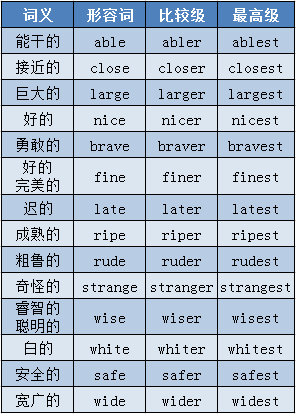
⒋ 以字母y结尾的形容词,把y改为i,再加上-er、-est构成比较级、最高级。
如:
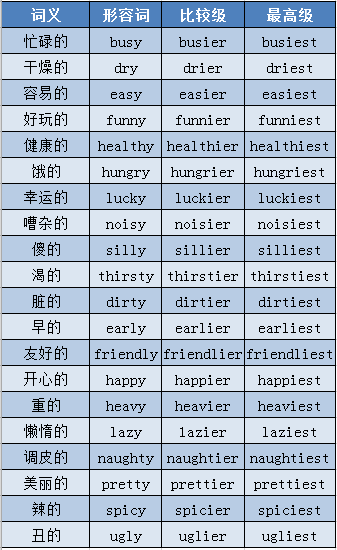
⒌ 双音节、多音节形容词,在单词前面加上-morel-mo成比较级、最高级。
如:
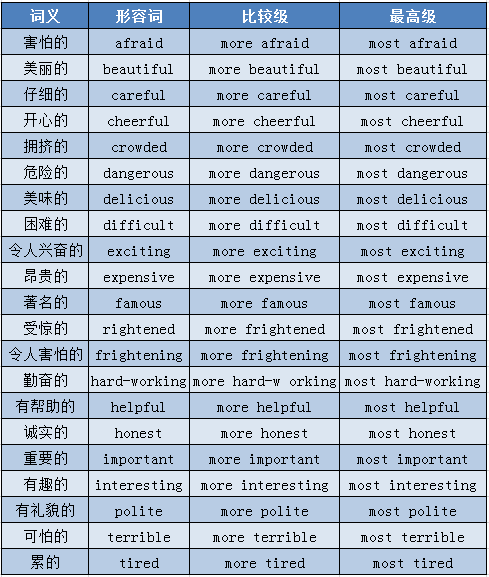
⒍ 不规则变化的形容词。
如:

2
原级用法
⒈ 原级比较:as+形容词或副词原级+as
① 在否定句或疑问句中可用so.…as。
例如:He can not run so fast as you.
② 当as.…as中间有名词时采用以下格式:
as +形容词+a+数名词
as+many/much+名词
如:This is as good an example as the other is.
I can carry as much paper as you can.
③ 用表示倍数的词或其他程度副词做修饰语时,放在as的前面。
如:This room is twice as big as that one.
I can carry as much paper as you can..
④ 用表示倍数的词或其他程度副词做修饰语时,放在as的前面。
如:This room is twice as big as that one.
Your room is the same size as mine.
⒉ 倍数表达法
① A is three(four, etc) times the size (height,length etc.)of B.
如:The new building is four times the size(the height)of the old one.这座新楼是那座旧楼的四倍大(高)/这座新楼比那座旧楼大(高)三倍。
② A is three(four, etc.) times as big (high,long,etc.)as B.
如:Asia is four times as large as Europe.亚洲是欧洲的四倍大/亚洲比欧洲大三倍。
③ A is three (four etc.) times bigger (higher, longer etc.) than B.
如:Your school is three times bigger than ours.你们的学校比我们的学校大三倍。
用times表倍数通常用于三倍以上,两倍可以用twice或double.
3
形容词比较级的用法
形容词的比较级用于两个人或事物的比较,结构形式如下:
⒈ A+is/ arm/are 形容词比较级+than+B
如:She is taller than
Tom is more athletic than Sam.
⒉ 比较级+and+比较级,表示“越来越”
例如:warmer and warmer
nicer and nicer
more and more beautiful
⒊ the+比较级……,the+比较级……
如:The more you read the book, the more interesting you found.
⒋比较级的修饰语有:much,far,even,a little,a bit,a lot 等。
如:He made fewer mistakes than I did.
He is even richer than I.
4
形容词最高级的用法
形容词最高级用于两个以上的人和物进行比较,其结构形式为:主语+谓语(系动词)+the +形容词最高级+名词+表示范围的短语或从句,比较常用在in,of 或among的结构中,形容词最高级前+the.
如:I am the best of the three.
He is the thinnest boy in my class.
5
重点与难点
⒈ 形容词原级表示比较级含义:
如:John is not so stupid as Mike.
John is less stupid than Mike.
John is cleverer than Mike.约翰不象迈克那么笨。
⒉ 用比较级表示最高级:
如:约翰是班里最高的男生。
John is taller than any other boy in the class.
John is the tallest boy in the class.
John is taller than any other boy.
⒊ the more.……the more..表示越.….越…….
如:The more books you read,the wider your knowledge is.
The more food you eat,the fatter you are.
⒋ more and more..表示越来…….越……
如:More and more students realized the importance of a foreign language.
Our country is getting stronger and stronger.
⒌ 如在两者间表示最……时,要在比较级前加the,而且还用of the two,of the pair短语:
如:John is the clever of the two boys.
of the two boys,John is the clever.

1
概念
副词和形容词一样,也有原级、比较级和最高级三个等级。其构成方式有规则变化和不规则变化两种情况。规则变化的一般规律是:单音节词的比较级和最高级在词尾加-er或-est;多音节词以及-ly结尾的副词(early 除外),前面加more或most。不规则的变化式只能采用“各个击破”的办法去记忆。
⒈ 规则变化
如:
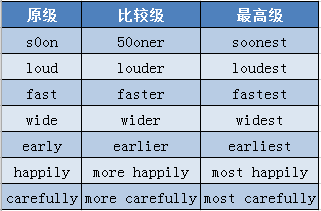
② 不规则变化
例如:
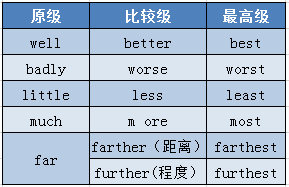
2
副间的比较级的用法
⒈ 单独使用
如:Try to do better next time.下次争取干好一点。
He'lI come back sooner or later.他迟早会回来的。
Please speak more slowly.请讲慢一点。
⒉ 和than一起使用
如:He swims better than I do.他游泳游得比我好。
Can you do any better than that.你能不能干的好一些?
He arrived earlier than usual.他到的比平时早。
⒊ 比较级前可有状语修饰
如:You must work much faster.你必须大大加快干活的速度。
Can you come over a bit more quickly?你能稍稍快点来吗?
⒋ as…as和not so…as结构这两个结构也可结合副词使用
① as…as可用在肯定句中,表示“像……一样",后面的副词要用原级。
如:She can run as fast as a deer.她能跑的像鹿一样快。
② 在否定句中,as…as和so…as都可以用。
例如:I don't go there as much as I use.我现在到那里不象过去那么多了。
I didn't do as(so)well as I should.我做的不如我应做的那么好。
③ 这种句子中也可以有一个表示程度的状语。
例如:She can read twice as fast as he does.她阅读的速度比他快一倍。
3
副词最高级的用法
副词最高级可修饰动词,前面多数不带定冠词 the。
如:He laughs best who laughs last.(谚语)谁笑在最后谁笑的最好。
of the four of us,I sang(the)worst.我们四人中我唱的最差。
4
副词比较级和最高级的一些特殊用法
副词比较级和最高级还可用在一些特别结构或短语中。
⒈ more and more 越来越……
例如:It rained more and more heavily.雨下得越来越大了
She went farther and farther away.她越走越远了。
⒉ the more..the more 越……越……
例如:The more I work,the more I accomplish.我干得越多,完成的就越多。
⒊ had better(not)do sth最好(不要)做某事
例如:We'd better not disturb him. 我们最好不要打扰他。
What had we better do?我们最员?

冠词(Article)是一种虚词,在句子中不重读,本身不能独立使用,只能放在名词前帮助说明名词所指的人或事物,它是英语词性中最小的一类,只有三个,一种是不定冠词(Indefinite Article),一种是定冠词(Definite Article)。此外也有些特定场合不用冠词,即通常所称的零冠词(Zero Article)。
1
冠词a / an 的基本用法
(定冠词a/an用法口诀)
某人某物属某类,
一人一物指全体;
某人某物不具体,
数量名词前表“每一”
⒈ 基本用法

⒉ a / an 的区别
a 用在辅音音素开头的单数可数名词或字母前,an 用在元音音素开头的单数可数名词或字母前。如 a book , an orange , an egg
注意:
① u发音为 / ju:/ 时,单词前用a. 如: a usual boy; a university; a unit; a useful book;注意另外两个特殊词: a one-leg table ; a European
② 常见辅音字母不发音的单词有:an honest boy; an hour; an honor
2
定冠词 the 的用法
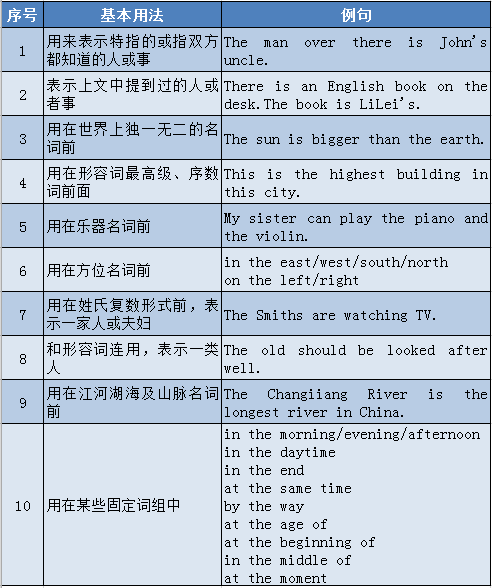
3
不用冠词的情况

注意:
⒈ 中国的传统节日前一般加“the”
如:the Mid-Autumn Day 中秋节; the Spring Festival ;
⒉ 具体某年的季节前一般加“the”
in the winter of 2009在2009年的冬天
如:⒊ 但三餐饭前如有形容词修饰时,可以用冠词
如:have a nice breakfast吃一顿美味的早餐
4
高考常见冠词形式
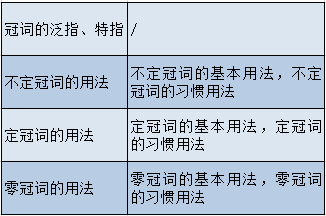
5
冠词的活用

动词的基本形式
绝大多数动词都有五种基本形式:动词原形、一般现在时第三人称单数、过去式、过去分词和现在分词。
一般现在时主语是第三人称单数时,谓语动词后要加s或es,其变化规则与名词变复数的方法大体相同:
1
规则动词变化表

2
不规则动词变化表
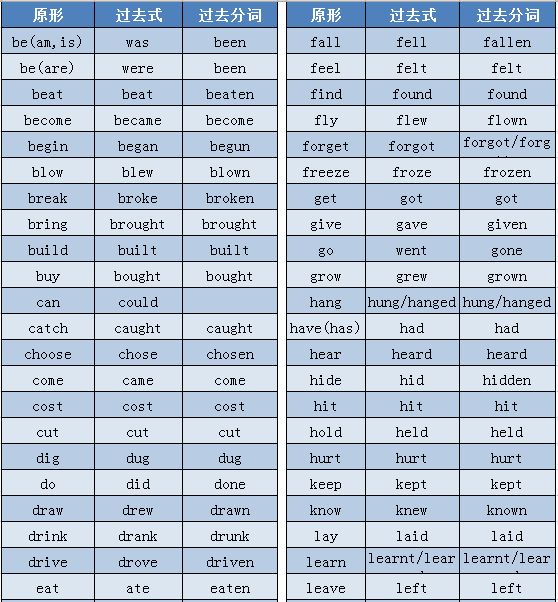
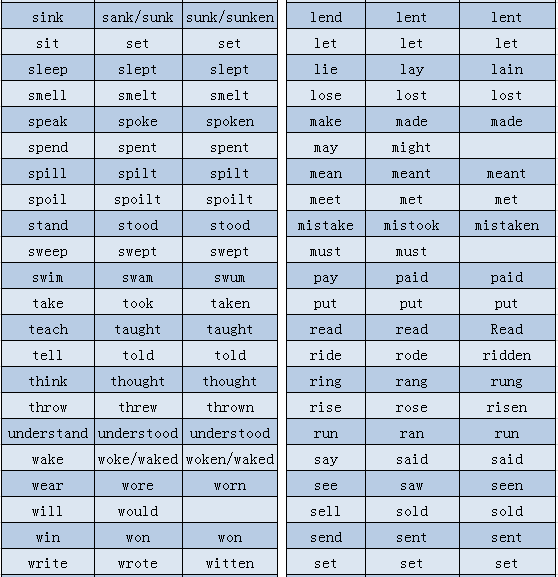

★ 系动词
1
概念及特点
连系动词,即系动词,是一个表示谓语关系的动词。它必须后接表语通常为名词或形容词。
连系动词的功能主要是把表语(名词、形容词、某些副词、非谓词、介词短语、从句)和它的主语联系在一起,说明主语的属性、特征或状态。它有自己的但不完全的词义,不能在句中独立作谓语,必须和后面的表语一起构成句子的谓语。 它是虚词。
2
系动词分类
⒈ 状态系动词:用来表示主语状态,只有be 一词。
如:He is a teacher.他是一名教师。(is与补足语一起说明主语的身份。)
⒉ 持续系动词:用来表示主语继续或保持一种状况或态度,主要有keep,rest,remain,stay,lie,stand。
如:He always kept silent at meeting.他开会时总保持沉默。
This matter rests a mystery.此事仍是一个谜。
⒊ 表像系动词:用来表示“看起来像“这一概念,主要有seem,appear,look。
如:He looks tired.他看起来很累。
He seems (to be) very sad.他看起来很伤心。
⒋ 感官系动词:主要有feel,smell,sound,taste。
如:This kind of cloth feels very soft.这种布手感很软。
This flower smells very sweet.这朵花闻起来很香。
⒌ 变化系动词:这些系动词表示主语变成什么样,变化系动词主要有become,grow,turn fal( asleep),get,go,come,run。
如:He became mad after that.自那之后,他疯了。
She grew rich within a short time.她没多长时间就富了。
⒍ 终止系动词:表示主语已终止动作,主要有prove,turn out,表达“证实”“变成“之意。
如:The rumor proved false.这谣言证实有假。
The search proved difficult.搜查证实很难。
His plan turned out a success.他的计划终于成功了。(turn out表终止性结果)
⒎ 使役动词:let,have,make使,让……
① Let/make somebody do sth
如:The teacher lets/makes them clean the classroom after school.
② Make sb/sth adj.
如:The story makes me happy.
The color makes it look beautiful.
③ Have somebody do sth让某人做某事
如:My mother haves me make the bed.
④ Have sth done让某物被……
如:I have my hair cut/washed.
3
特例
有些动词它们既可以用作实义动词,又可以用作连系动词。另外be还可用作助动词。它们的用法不同,词义和句型结构也有所不同。
如:Look at the blackboard,please.请看黑板。(look用作实义动词)
He looks a little tired.他略显疲倦。(look用作连系动词)
They are at work.他们在工作。(are用作连系动词)
They are working.他们正在工作。(are用作助动词,帮助构成现在进行时)
★ 及物动词和不及物动词
英语中按动词后可否直接跟宾语,可把动词分成不及物动词与和及物动词。
1
不及物动词
不及物动词后不能直接跟有动作的对象(即宾语)。若要跟宾语,必须先在其后添加上某个介词,如to,of ,at后方可跟上宾语。具体每个动词后究竟加什么介词就得联系动词短语。
如:listen to,look at….
⒈ look 看 (vi.)+……+宾语(即不能直接加宾语).
如:Look! She is singing.
Look carefully! (注意:carefully 是副词,不是名词,故不作宾语)
look at (看…….)+宾语
如:Look at me carefully! (me是代词,作宾语)
⒉ 分清及物不及物动词
分清动词的及物不及物是在英语学习中必须解决的首要问题。动词及物与不及物通常有以下几种情况:
① 主要用作及物动词。及物动词后面必须跟宾语。可以用于:"主+谓+宾";"主+谓+双宾";"主+谓+宾+宾补"结构。
如:He reached Paris the day before yesterday.
Please hand me the book over there.
They asked me to go fishing with them.
类似的还有:buy, catch, invent, found, like, observe, offer, prevent, promise, raise, find, forget, receive, regard, see, say, seat, supply, select, suppose, show, make, take, tell…
② 主要用作不及物的动词。不及物动词后面不跟宾语。只能用与:"主+谓"结构。
如:This is the room where I once lived.
类似的还有:agree, go, work, listen, look, come, die, belong, fall, exist, rise, arrive, sit, sail, hurry, fail, succeed....
③ 既可以用作及物又可以用作不及物的动词,其意义不变。如begin 都是作"开始"讲。
如:everybody , our game begins.
let us begin our game.
类似的还有:start, answer, sing, close, consider, insist, read, learn, prepare, pay, hurt, improve....
④ 既可以用作及物又可以用作不及物的动词,其意义完全不同。这类动词作不及物动词是一个意义;而作及物动词时却是另一个意义。
如:lift作不及物动词时是指烟雾的"消散"。
例句:we saw the mountain when the clouds lifted.
作及物动词时是"升高;举起"。
例句:He lifted his glass and drank.
类似的还有:

需要注意的一点是:少数不及物动词唯一可跟的宾语是同源宾语。
如:I dreamed a dream last night.
★ 助动词
1
概念
助动词是帮助主要动词构成各种时态,语态,语气以及否定或疑问结构的动词,助动词分为时态助动词和结构助动词两种。
2
特点
⒈ 助动词自身没有词义,不可单独使用。
如:He doesn't like English他不喜欢英语。(doesn't是助动,无词义;like是主要动词,有词义。)
⒉ 助动词协助主要动词完成以下功用,可以用来:
① 表示时态
如:He is singing.他在唱歌。
He has got married.他已结婚。
② 表示语态
如:He was sent to England.他被派往英国。
③ 构成疑问句
如:Do you like college life?你喜欢大学生活吗?
④ 与否定副词not合用,构成否定句
如:I don't like him.我不喜欢他。
⑤ 加强语气
如:He did know that.他的确知道那件事。
⑥ 最常用的助动词有:be,have,do,shall,will,should,would
⑴ 半助动词
在功能上介乎主动词和助动词之间的一类结构,称为半助动词。常见的半助动词有be about to,be due to,be going to,be likely to,be meant to,be obliged to,be supposed to,be willing to,have to,seem to,be unable to,be wiling to等
⑵ 情态助动词
a. 情态助动词包括will(would),shalshould),can(could),may(might,must,need,dare,ought to,used to,had better 后接原形不定式。
b. 情态助动词不受主语的人称和数的限制。
c.两个情态助动词不能连用。
中文:他将能够及时完成此事。(误)He will can finish it in time.
⑶ 基本助动词
基本助动基本助动词只有三个:be、do、have,他们没有汇意义,只有语法作用,和实意动词一起构成谓(叫复合谓语),表达否定、疑问、时态、语态和其他语法关系。其基本形式和作用如下表:

3
助动词的分类
⒈按结构分:时态助动词和结构助动词
⒉ 时态助动词有:be(am,is,are;was,were),have(has,had),will(would)和shall(should)和主动词一起构成各种时态、语态和语气。
⒊ 结构助动词:do(does,did),本身无词义,它仅为无助动的动词提供助动词,构成疑问结构和否定结构。
4
助动词具体用法
时态助动词同主动词一起构成十六种时态和十种被动语态结构。注意:被动语态没有完成进行时和将来进行时态。
⒈ 助动词be的用法
助动词be 有八种形式:

注意:它们的肯定、否定、缩略形式。第一人称的反意疑问句的句尾中用aren't;be的现在词和过去分词的否定形式是在前加not being和not been它们没有缩略形式。
①be +现在分词,跟现在分词构成各种进行时态
如:We are playing video games on TV last night.我们在电视上玩电子游戏。
② be+过去分词,跟过去分词构成被动语态
如:He's not respected by the press.他们不受报界的尊重。
注意:be+过去分词”不一定都是被动语态,有时可能是系表结构,两者主要区别是:被动语态表示以主语为承受者的动作;而系表结构则表示主语的特点或所处的状态。
③ be(am,is,are)动词不定式,可表示下列内容
⑴ 用现在时表示最近、未来的计划或安排。说明:这种用法也可以说成是一种将来时态表达法。
如:He is to go to New York next week.他下周要去纽约。
⑵ 表示命令
如:You are to explain this.对此你要做出解释。
⑶ 征求意见
如:Who is to go there?谁该去那儿呢?
⑷ 表示相约、商定
如:We are to meet at the school gate at seven tomorrow morning.们明天早晨7点在校门口集合。
⒉ 助动词have的用法:
助动词have的五种形式:

⒊ 助动词do的用法:
结构助动词do三种形式

① 帮助构成实意动词一般现在时和一般过去时的疑问式和否定式:
如:Do you know John?你认识约翰吗?
Mary didn't come to see me yesterday.玛丽昨天没来看我。
You like this picture,don't you"?你喜欢这张画,不是吗?
② 代替前面已经提到过的动词,避免重复:
如:—Do you smoke?你抽烟吗?
—Yes,I do是的,我抽。
I moke. So does he.我抽烟。他也抽。
He doesn't like it.Neither do I.他不喜欢,我也不。
③ 帮助加强谓语动词的语气,该do、does或did要重读;did加强过去时谓语动词语气时,这个谓语动词要用原形。
如:l do like you.我真的喜欢你。
She/He does like you.他确实喜欢你。
She/They/We did go swimming yesterday.她/他们/我们昨天确实去游泳了。
⑴ 另外:如果谓语中有助动词或情态动词,要加强语气时就能用do的各种形式来强调,一般方法是把需要强调的词全用大写字母来书写。
⑵ 一般祈使句前面加助动词do构成肯定的强语势祈使句,末尾加感叹号。
⑶ 第二人称祈使句强调语气有两种其它形式:
a. 用never 代替don't.
b. 主语you不省略或不加呼语。
如:Find yourself someone else to shout at.你跟别人喊去!
c. 当谓语动词前有否定意义的副词(never,seldom,hardly,rarely,scarce等)时,起强调作用的助动词(do,does,did)要加在该动词前面而不是加在副词的前面。
如:He seldom does come late.他的确极少迟到。
d. 注意:be,have,do都能做实意动词用:
如:These are computers.这些是计算机。
We're having breakfast.饿们正在吃早饭。
I did some washing last night.我昨晚洗了衣服。
④ 构成否定祈使句,说明:构成否定祈使句只用do,不用did和does。
如:Don't go there.不要去那里。
Don't be so absent-minded.不要这么心不在焉。
⑤ 用于倒装句。
如:Never did I hear of such a thing.我从未听说过这样的事情。
说明:引导此类倒装句的副词有never,seldom,rarely,little,only,so,well等。
⒋ 助动词 shall 和will的用法:
① 助动词shall/will构成一般将来时;should/would构成过去将来时。
如:We shall/will be rich,if we succeed.我们将很富有,如果我们成功的话。
They will be rich,if they succeed.他们将很富有,如果他们成功的话。
They said they would be rich,if they succeeded.他们说他们将很富有,如果他们成功的话。
② shall用在第一、三人称作主语的疑问句中,来征求意见,表示“要不要……”。
如:Shall I go now?要我现在就走吗?
Shall the reporters wait outside or what?要记者们在外面等还是怎样?
③ shall用于所有人称,表示说话人的决心、保证、许诺、威胁、警告、命令等强烈的感情。
如:You shall have an answer by tomorrow.到了明天,你会得到答复的。
The enemy shall not pass.决不允许敌人过去。
The ceremony shall not be postponed/put off.仪式不会推迟的。
④ would可以表示过去的习惯,类似used to
如:He would come to see me on Sunday when he was here.他这里的时候,星期天就来看我。
⑤ wil可以表示“愿意、肯、会、固执”等意义,而非将来
如:l will pay you for it.我会付给你钱买下它的。
⑥ will可以表示倾向、习惯(总是会,老是等意思),在否定句中可以表示不肯、不能”等意思:
如:Boys will be boys.男孩子总归是男孩子。
0il and water will not mix.油和水是不会混合在一起的。
This machine won't work.这台机器不工作了坏了。
These things will happen.这样的事情总是会发生的。
5
再论助动词
⒈ be have和do(主要的助动词)
① 在否定句和疑问句中,be与do的用法遵从助动词的下列规则:
⑴ 否定句中,助动词+not
如:He isn't coming.他不来了。
lt did not matter.没关系。
⑵ 疑问句中,主语+助动词
如:Was he waiting?他当时在等吗?
Does she see us?她看到我们了吗?
② have在疑问句及否定句中的位置一般与助动词相同
如:Has he(got )to go?他一定得走吗?
但有时也用do/did形式
如:Does he have to go?他一定得走吗?
③ be与带to的动词不定式连用
如:They are to wait for us at the station.将在车站等我们。
have 后也可接带to的动词不定式,但有两种结构除外。do 与不带to的不定式(即动词原形)连用:
如:Did he write?他写信了吗?
④ be have和do作助动词使用时,需要带分词或不定式,但在答句或评语等中常省略。
如:—Have you seen t-你看见了吗?
—Yes,I have(seen it)一是的,(我看见了)。
⑤在be,have和do作普通动词使用而有自己本身的意思,如have有“拥有”的意思、do有“干/从事”的意思等时,它们只能是句子中唯一的动词:
如:He is lazy.他很懒惰。
He has no job.他没有工作。
He does nothing.他什么事也不干。
在这种情况下,do与助动词do/did 连用:
如:What do you do in the evening?你一般晚上做什么?
have可以用两种方法进行变化,即用助动词do/did 或不用:
如:Have you(got)time?/Do you have time?你有空吗?
⒉ can,could,may,might,must,ought,will,would,shall和should 是情态动词,也称情态助动词。
①情态动词的第三人称单数后不加s
如:lmust我必须
he must他必须
I can我可以
he can他可以
② 它们在构成否定形式和疑问形式时均遵循助动词的规则
eg.will not…
ought not……
will he……?
bught he..?
③ 它们没有真正的过去时态。情态动词有四种过去形式,即could,might,should和would,但用途有限。
④ 情态动词没有不定式或分词形式,所以不能用于进行时态。
⑤ 除ought之外其他情态动词后一律跟不带to的动词不定式(即动词原形)
如:You should pay./You ought to pay.你应该付钱。
情态动词后面应带动词原形(而非分词等),但有时该动词可省略;
如:—Can you understand? -你明白吗?
—Yes,I can(understand)-是的(,我明白)。
⒊ need,dare和used(半情态动词)
① 当need和dare作助动词时,可遵循情态动词的句式,后面跟不带to的动词不定式
如:He need not wait.他不用等。
但也可与do/did 形式连用,这时后面要接带to的动词不定式:
如:He doesn't dare to interrupt.他不敢插嘴。
They didn't need to wait.他们不需要等。
注意:need和dare也可作普通动词用,有词形变化,并可与分词连用:
如:He needs help.他需要帮助。
They dared me to jurmp.他们激将我,要我跳下去。
② used有时说成used to,只指过去的事。它的否定式和疑问式常常遵循助动词的规则
如:l used not/usedn't to go.我一向不去。
虽然严格来讲used不带不定式,但经常可以听到didn't use to和did he/she等+use to?的形式。
6
分析助动词和情态动词的异同
⒈ 相同点:
① 都可构成疑问句,并且都能用在肯定或否定的简略式回答中。
如:Was the car going beyond the speed limit?车是否在超速行驶?
Yes.it was.是的,在超速行驶。
② 都可与not连用构成否定句。
如:At first,it didn't sell very well.初,它的销路不好。
③ 都能构成反意疑问句。
如:You didn't let me drive,did you?你没有让我开车,对吗?
④ 都可以在so…或neither(nor)…句型中,代替前面的动词(短语)。
如:You can't do it,nor can I,nor can anybody else。不能那样做,我也不能,任何人都不能。
⒉ 不同点
谓语中只能有一个情态动词,但可有多个助动词。
如:He was being trained to be a doctor.他时正接受培训,要成为一名医生。
情态动词
情态动词是表示能力、义务、必须、猜测等说话人的语气或情态的动词。
1
can
⒈ 表能力:can表能力时意味着凭体力或脑力或技术等可以无甚阻力地去做某事。
如:I can climb this pole. 我能爬这根杆子。
He is only four , but he can read.他只有4岁,但已认得字了。
Fire can’t destroy gold.火烧不毁金子。
因为can不能和其他助动词连用,所以表示将来式时用will be able to
如:You will be able to skate after you have practiced it two or three times.你练习两三次后就会溜冰了。
⒉ 表可能性:多用于否定与疑问结构中,但也可用在肯定句中。
如:Can the news be true? 这消息可能是真的吗?
It can’t be true. 它不可能是真的。
What can he possibly mean? 他可能是什么意思?
can 用在肯定句中表示理论上的可能性(一时的可能


